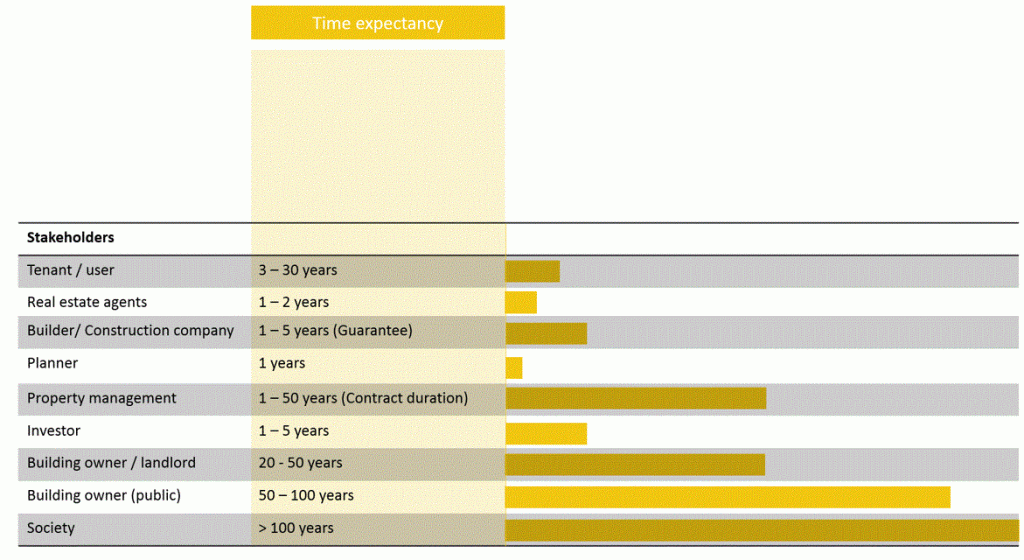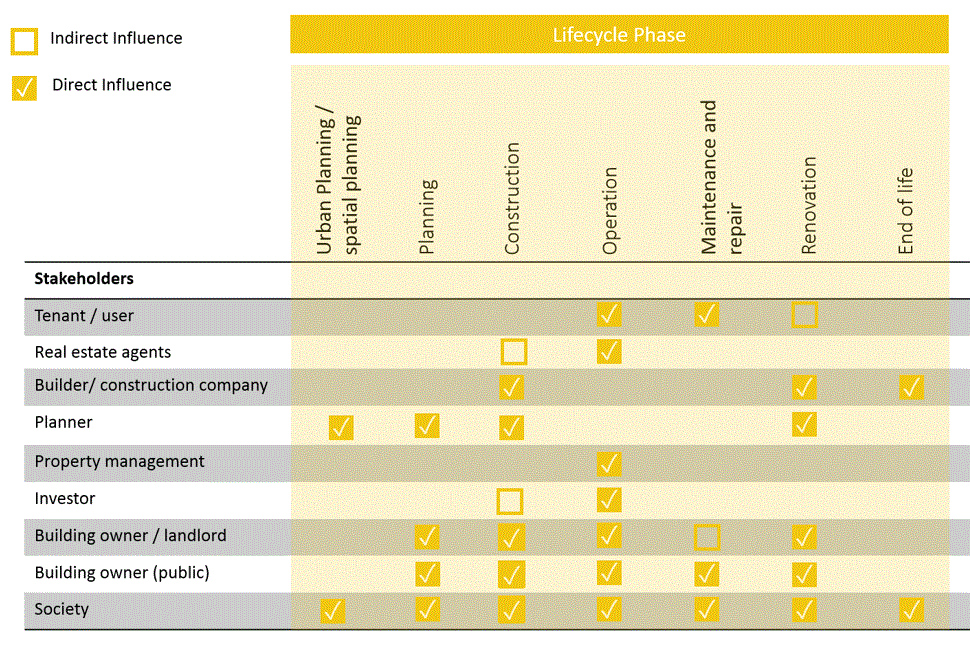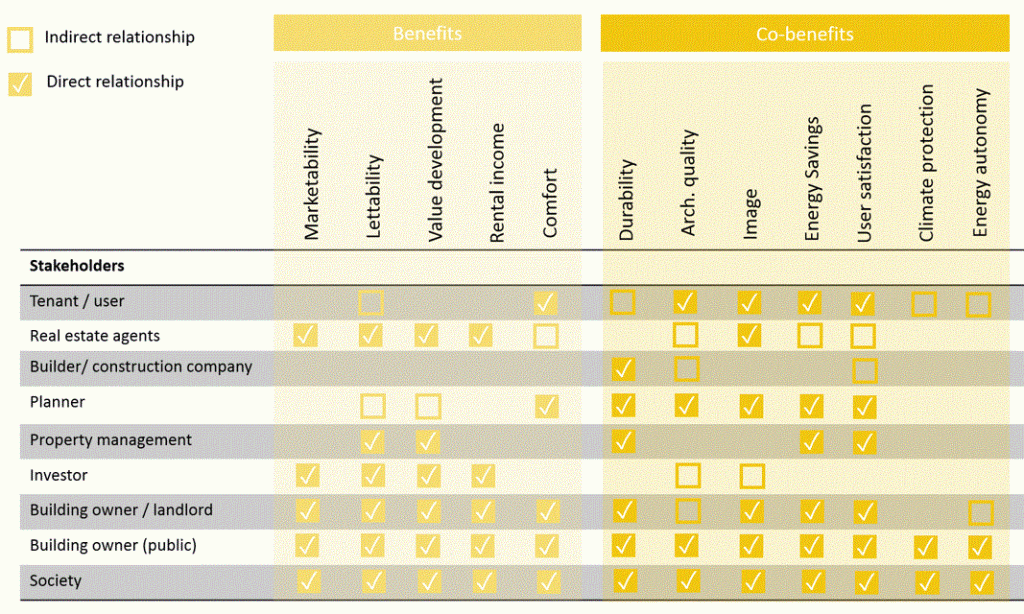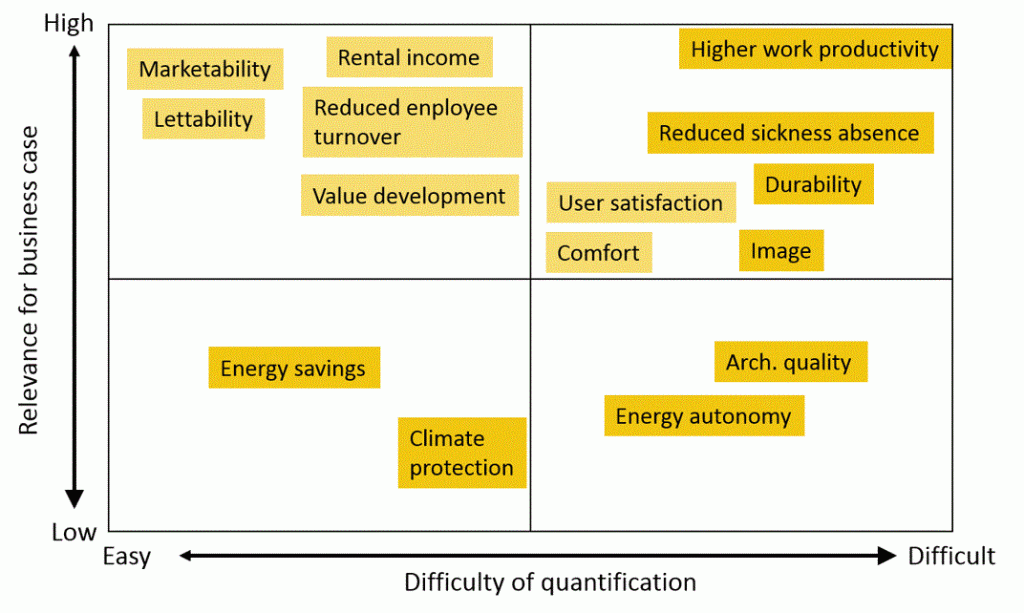
Stakeholder related processes

Figure1 Stakeholders’ time expectancy of a nZEB project
In order to be able to optimise existing processes, technical qualifications, actions to be taken and roles must be known and tasks and functions of the stakeholders assigned. The assessment of the process for nZEBs depends strongly on the perspective. Building owners, investors, tenants, the construction industry, providers of energy efficiency solutions and planners have different interests and are involved in different phases in the life cycle of buildings. There is a general lack of understanding, transparency and uniform methods when it comes to the overall process of nZEBs. Which costs and time horizons are significant for different actors and to what extent?
Figure2: Stakeholders’ influence in nZEB life cycle phases

In the life cycle of a building, there are different interests of the actors and derived from this also different perspectives, observation periods and target values. There is the tenant/user, the real estate agent, the building contractor, planner, property manager, investor, owner and also the company which is directly or indirectly involved in the building process. As shown in Figure 1, these actors are involved in the overall process over a certain period of time. While the tenant is primarily interested in the operational phase, the planner is usually more likely to deal with the building only until its completion. If a property is financed and used by the resident himself, the entire life cycle up to a change of use is usually of interest. Depending on the approach, this can be between 25 years, after repayment of the bank loan, and up to 50 years, after increased consideration of the use. For society as a whole, the entire service life of a building, including its demolition and disposal, usually counts. The period under consideration must, therefore, be determined in advance with the parties involved. For most of the considerations of the entire building, between 25 and 50 years have proven to be reasonable.
Co-Benefits
Similar to the stakeholder related-processes, the different target criteria and co-benefits also vary depending on the perspective of the stakeholder. Figure 3 shows the criteria and co-benefits according to the interests of the different actors. In addition to low rental costs, the tenant is also interested in low operating costs and thus in a good energy standard, e.g. so that he or she has low heating costs. The building contractor is usually anxious to keep his or her building costs low. In the case of owner-occupied real estate, both cost components are important, the initial investment as well as the running costs. For public owners and users the total life cycle costs and also the effects such as CO2 emissions are important.

In addition to the optimisation criteria and thus the benefits that can be directly assessed in monetary terms, there are also different co-benefits for the individual actors, which often cannot be assessed directly in monetary terms and therefore do not appear in the life cycle cost analysis. These benefits and co-benefits are shown in Figure 4. These concern marketability, rentability, value development, comfort, but also image, climate protection or regional goals such as energy autonomy. Where possible, these benefits and additional benefits should be taken into account in the decision-making process. These additional criteria can often overlap the main criteria. An example of this is the use of an air heat pump in a very noise-sensitive environment. The air heat pump can perform relatively well in terms of energy and costs, also in terms of life-cycle costs, but can lead to problems due to increased noise pollution at the property and the neighbouring properties. It is important to quantify added value of nZEBs in monetary terms, communicating and presenting business opportunities in a business language that potential investors are familiar with, as technical performance is less likely to attract their interest (Bleyl, 2016). Co-benefits such as increased productivity, improved health, publicity value, etc. need to be quantified. The calculation may not be complex; the challenge is to gather well-proven input data for the calculations.
However, examples exist where increased productivity, higher revenue, reduced employee turnover, reduced absenteeism, etc. have been quantified (Brew, 2017). Additionally, studies do exist which may be used as a basis for analysing added values.
Studies show that staffs in green buildings perceive a positive effect of their work environment and productivity (Thatcher, 2014) (Brew, 2017) (Singh, 2010). In one case, a 10 000 m2 office building, increased productivity of 0.3 % was reported, equal to 8 €/m2a.
Two studies have found reduced absenteeism in green buildings (Thatcher, 2014).
An American study showed that roughly 20-25 % of 534 companies reported higher employee morale, easier to recruit employees and more effective client meetings (Miller, 2009). Additionally, 19 % reported lower employee turnover.
In addition to well-being and productivity, higher revenues from rent or sales may be expected. Bleyl et al. reviewed previous studies and concluded that higher rent income might range roughly between 5 % and 20 %. Furthermore, higher market valuations may range from below 10 % to up to 30 %.
It should be noted, in relation to green buildings, productivity and wellbeing, that a recent study pointed out, that social factors may have a greater impact, in monetary terms, than environmental factors (Hugh, 2016).

The value of a positive news article about a specific building or a specific project could also be comparable to advertising costs in the specific source, in which the article is published (Berggren, 2017). One way to discuss the importance and investigation on different co-benefits may be to rank them as presented in Figure 4. The classification is a subjective judgement, highlighting the relevance and the difficulty in valuing the co-benefits discussed above.

